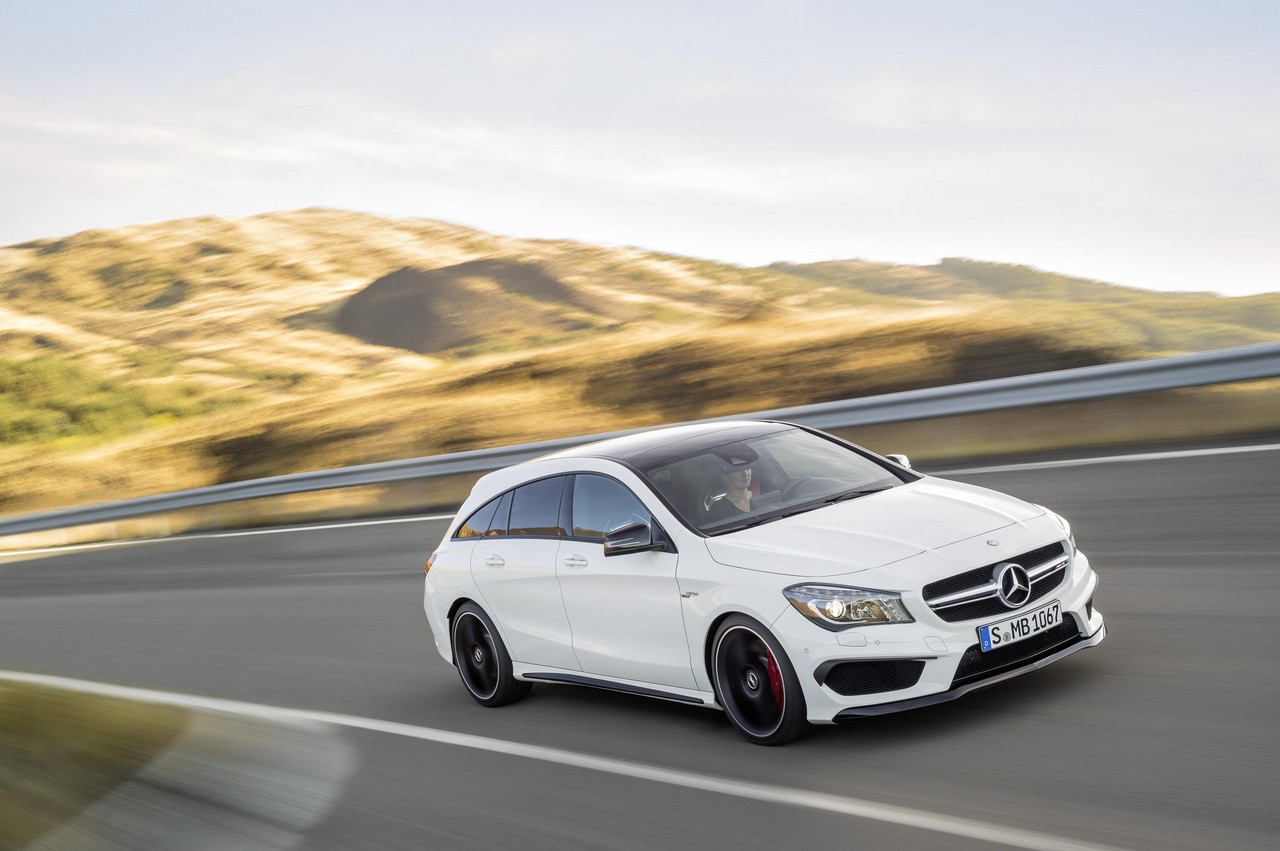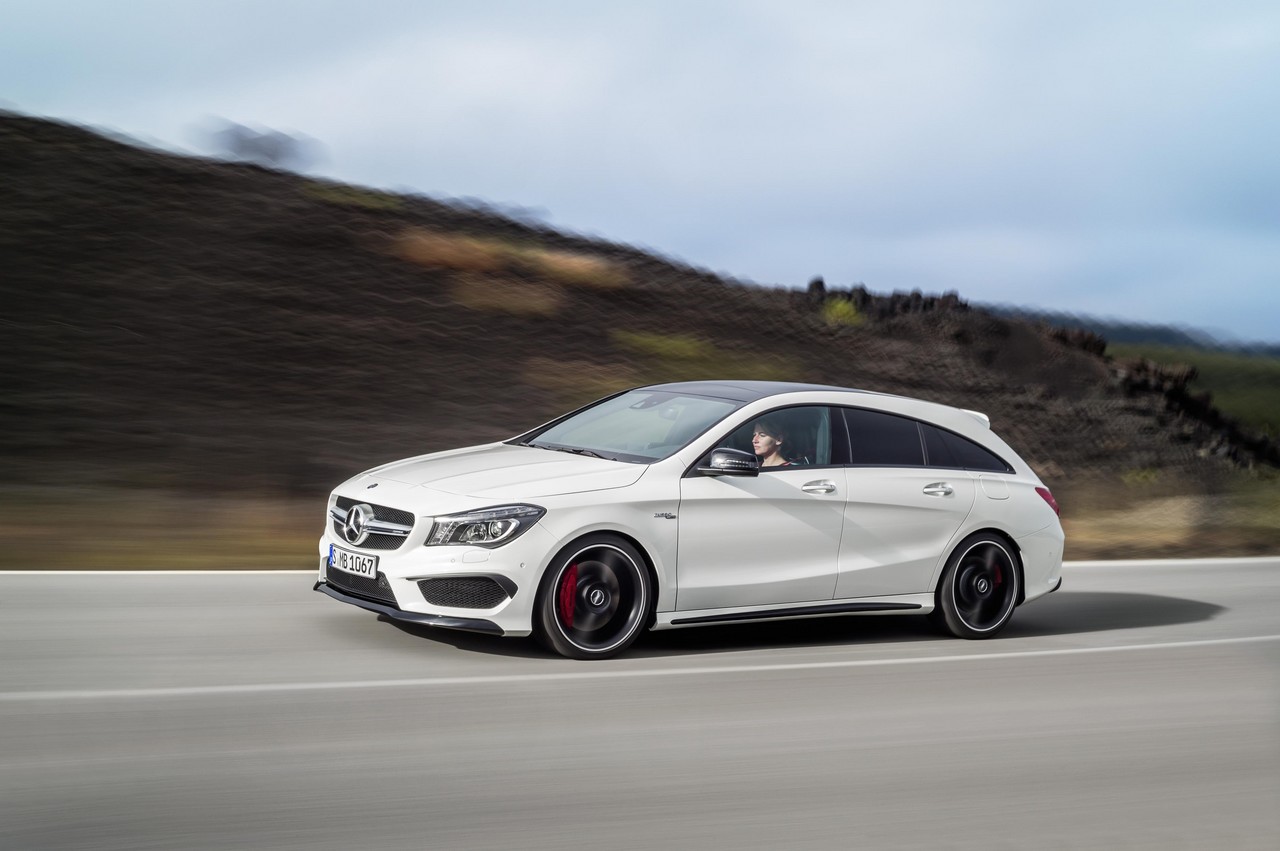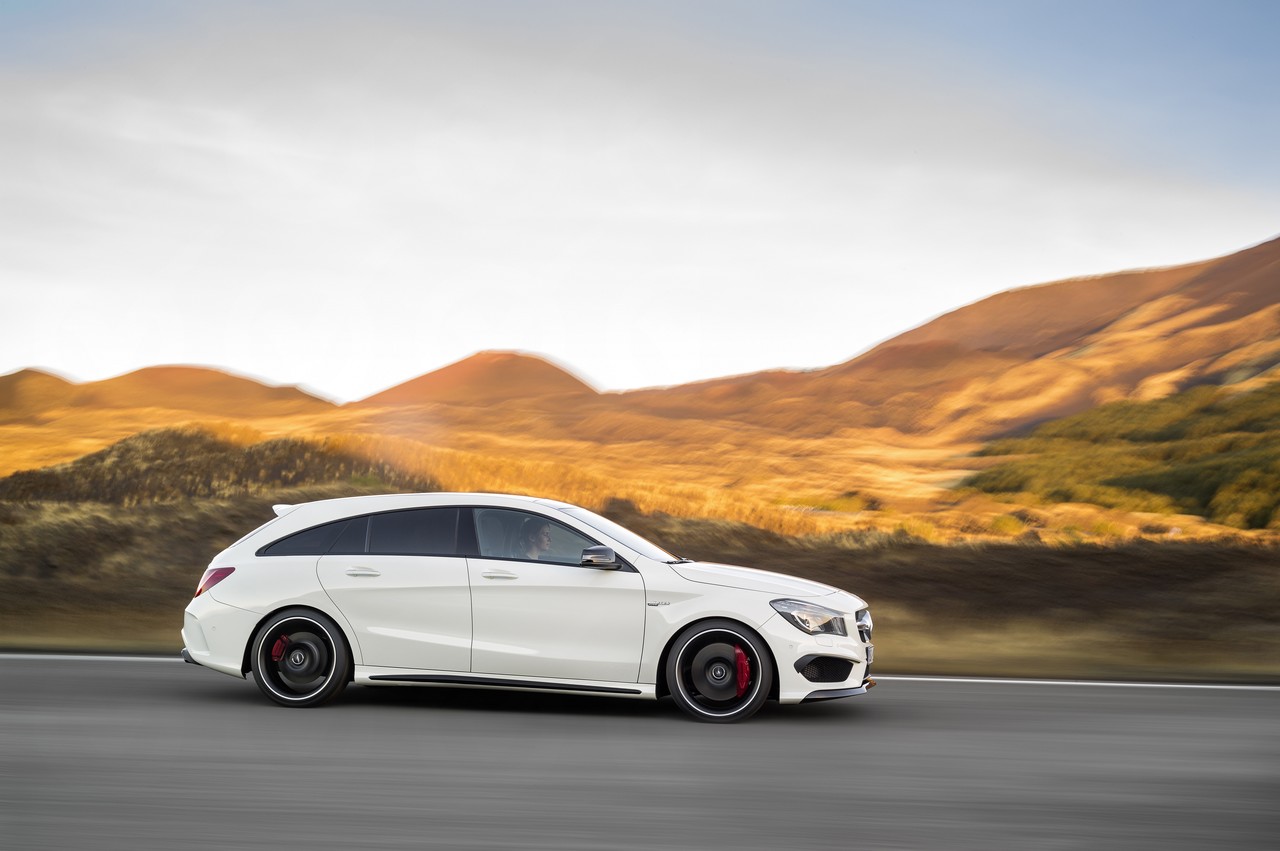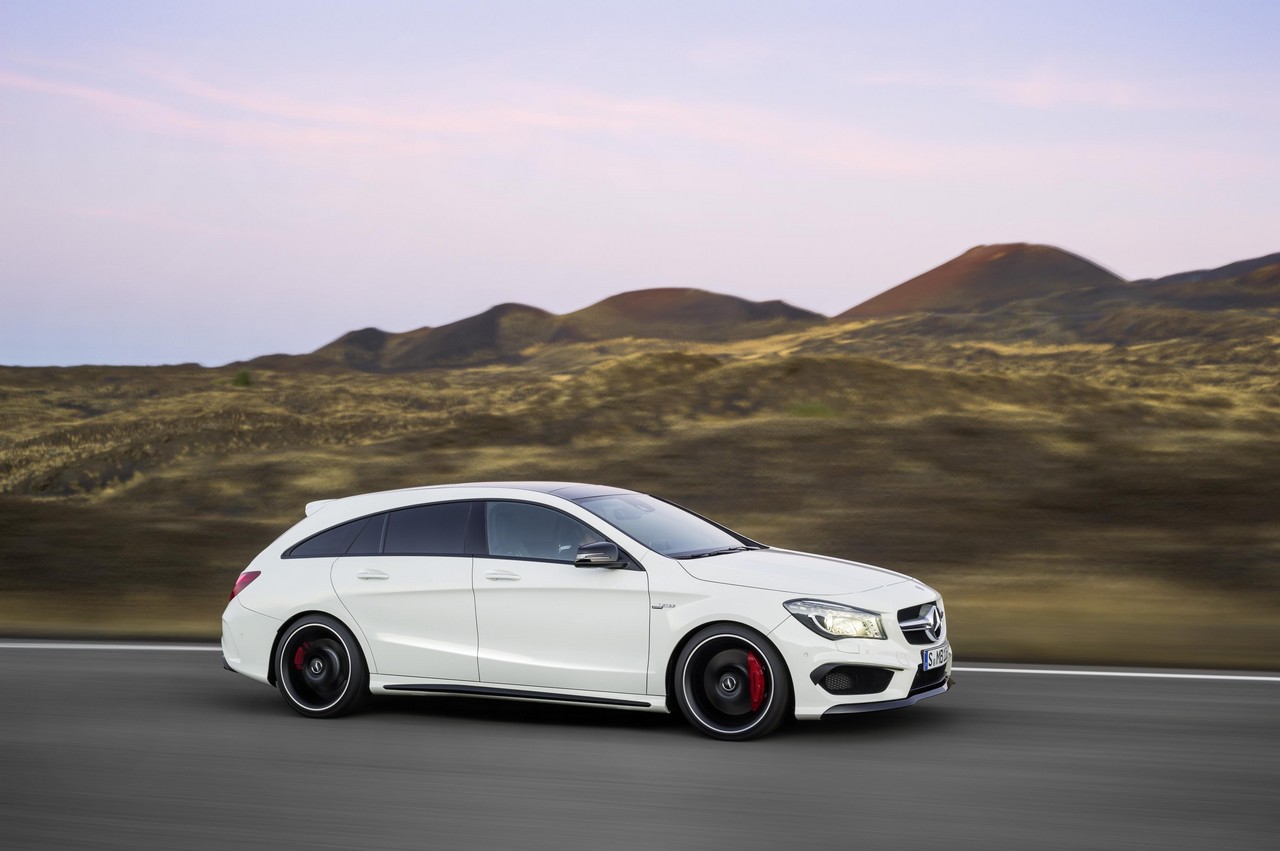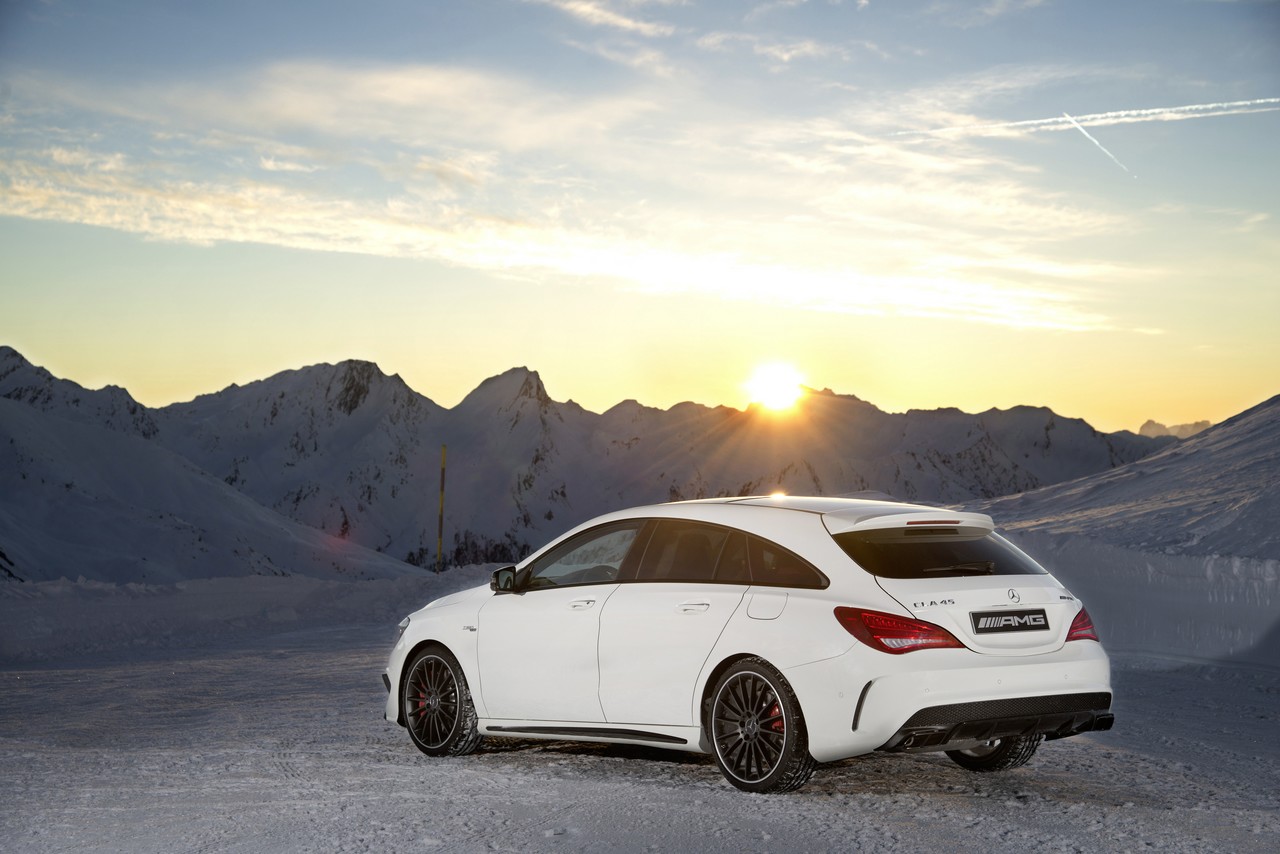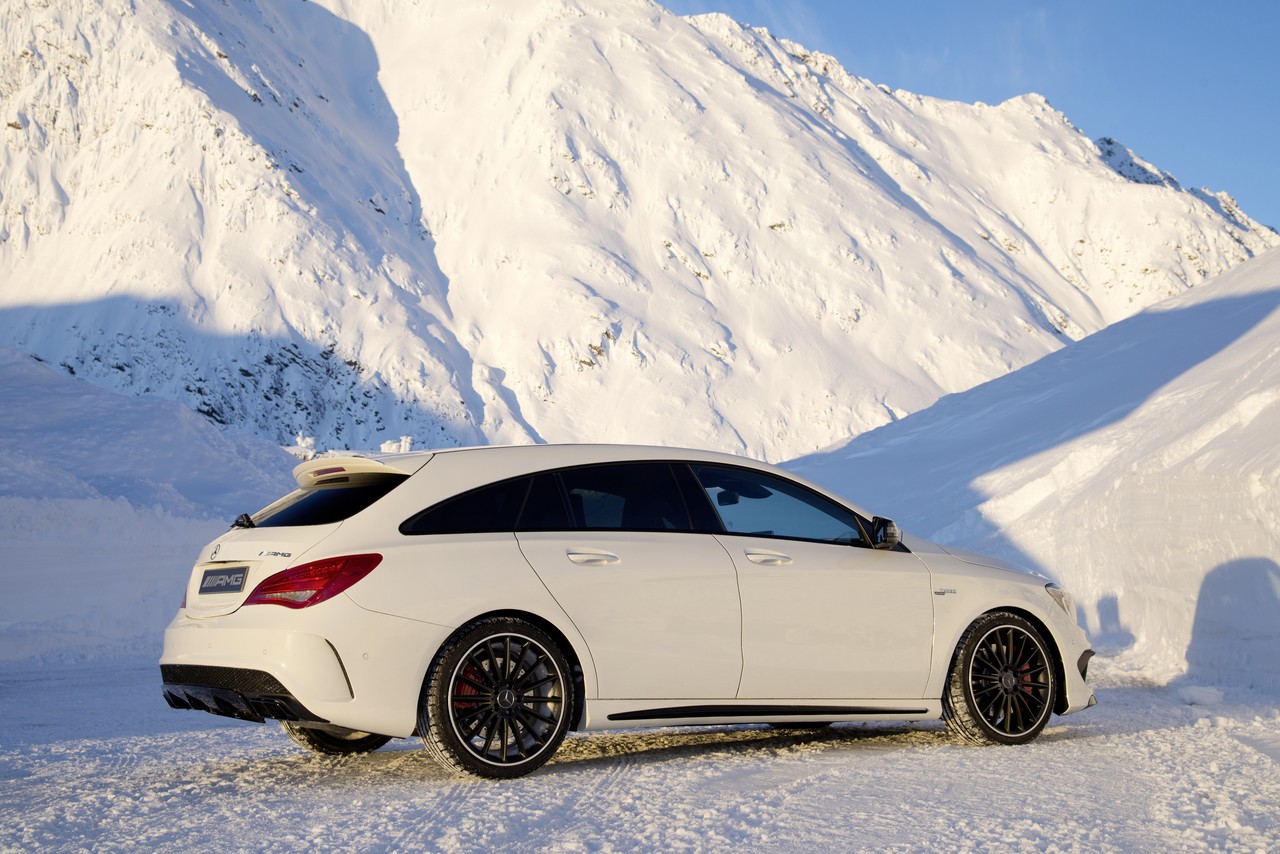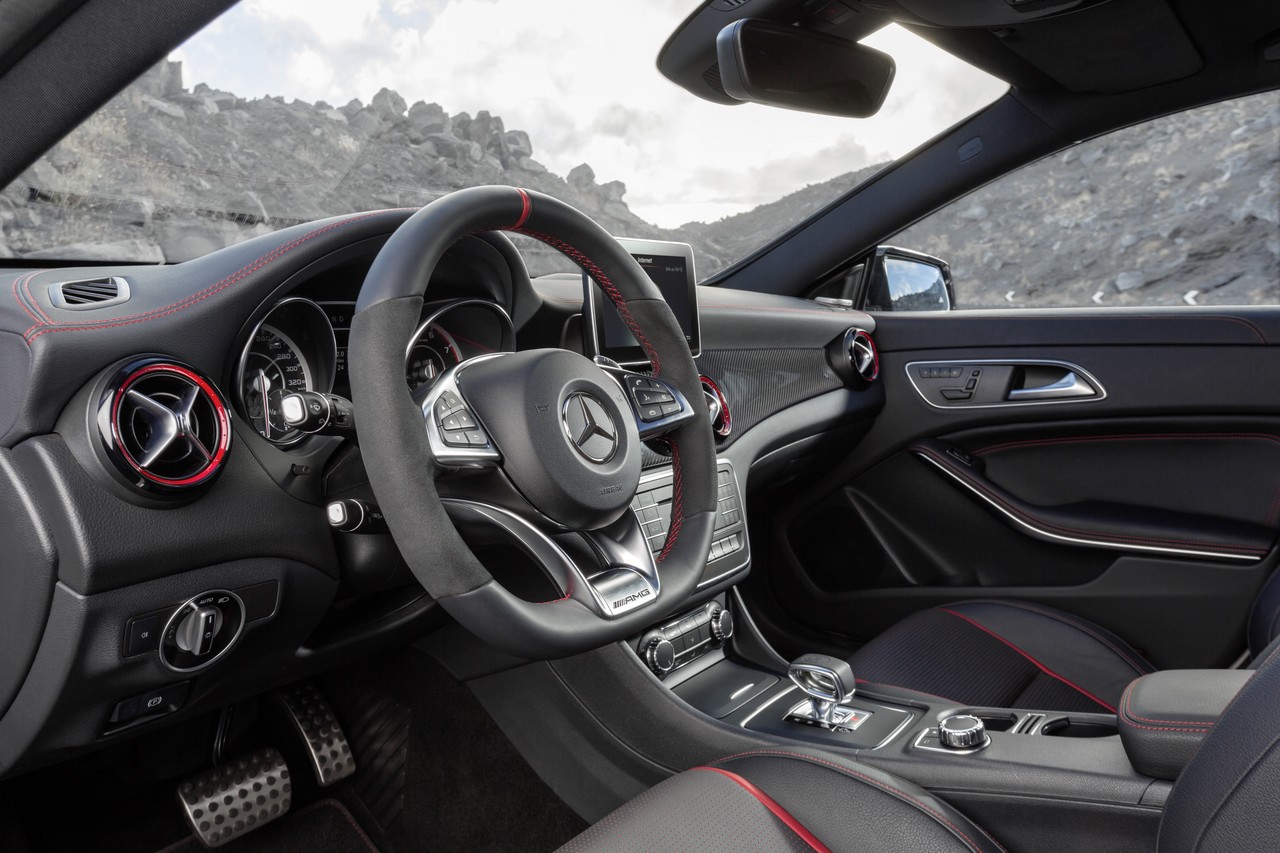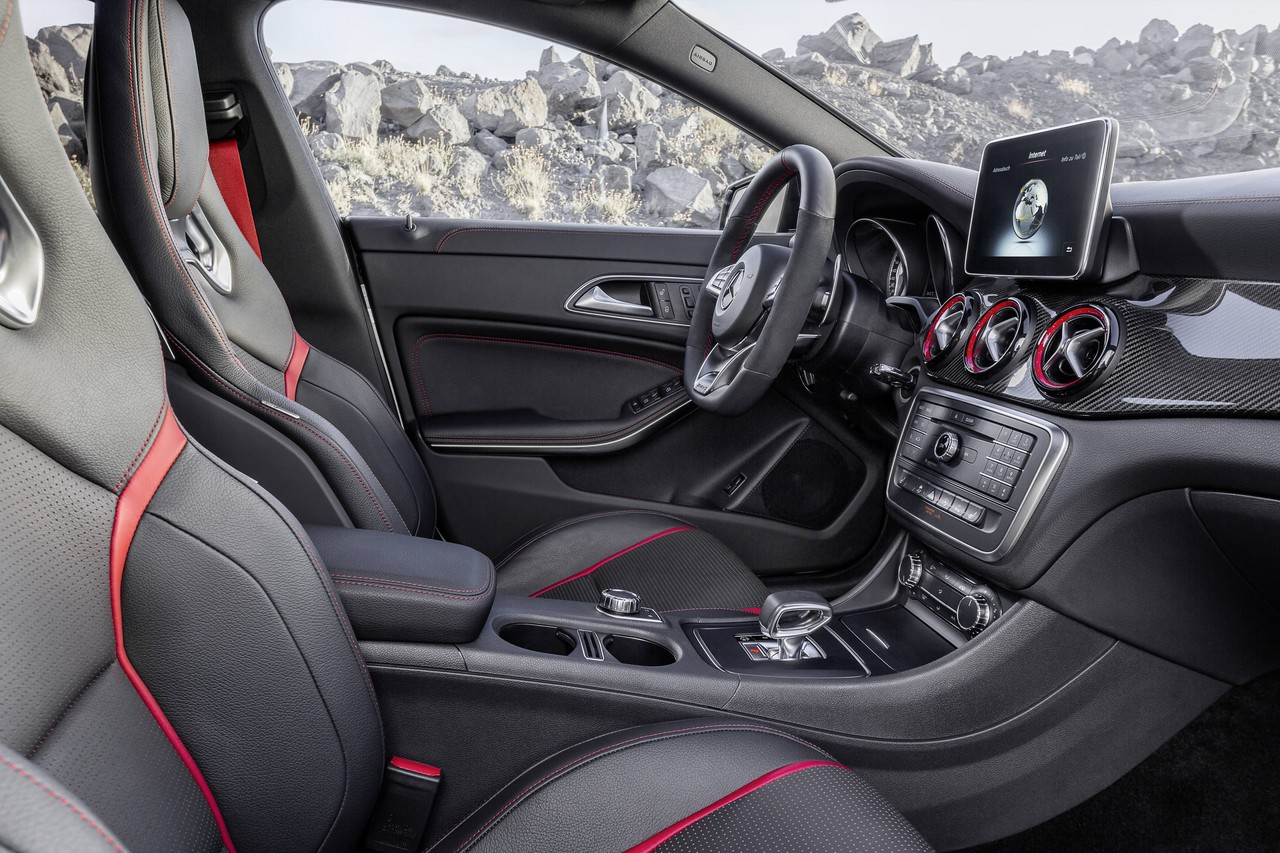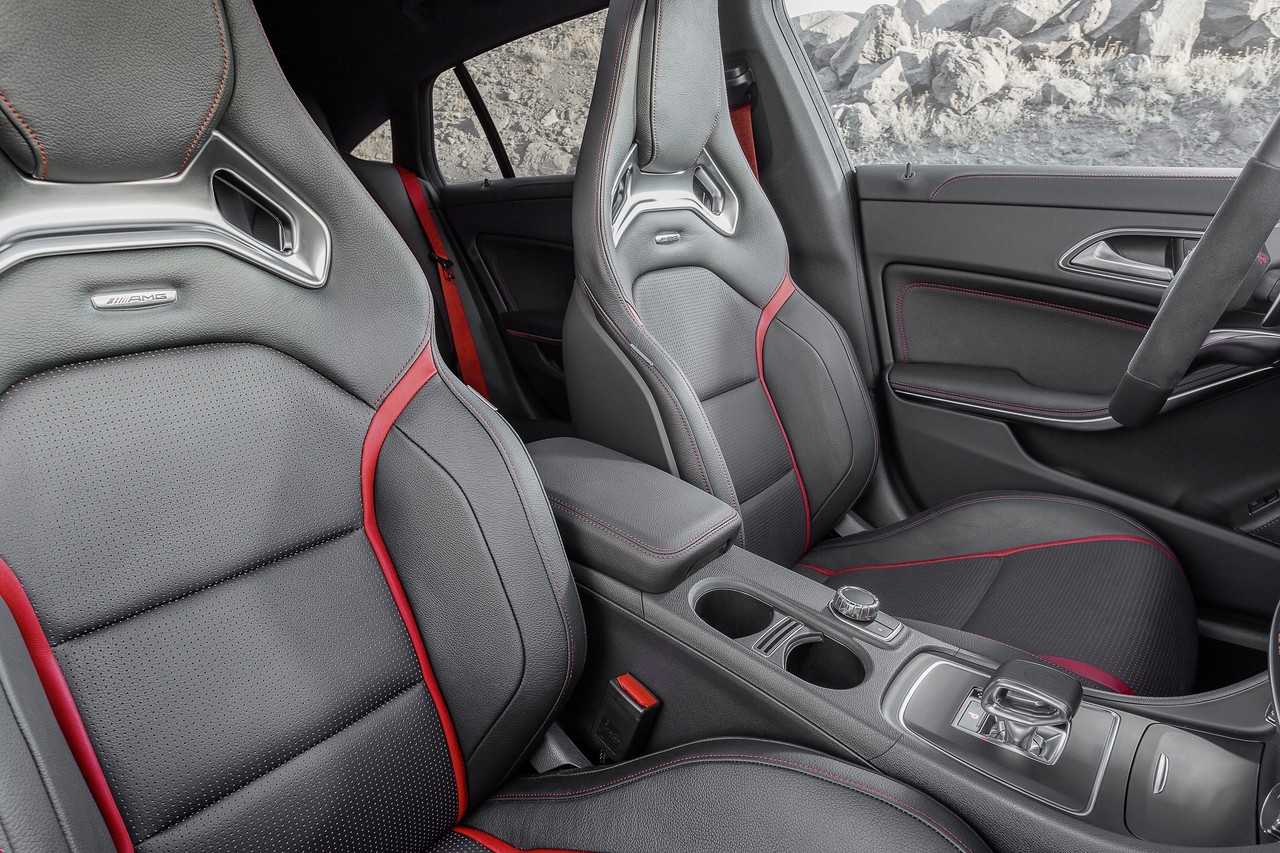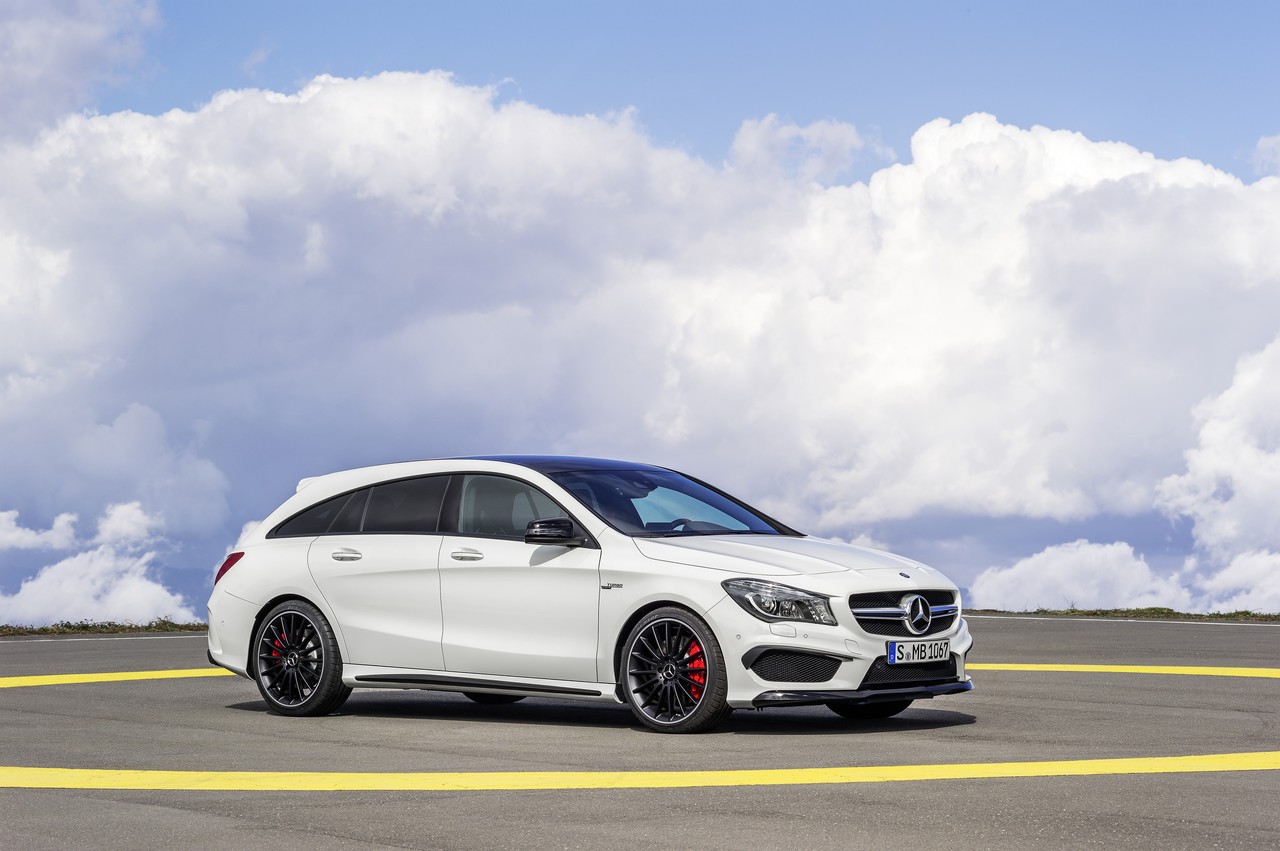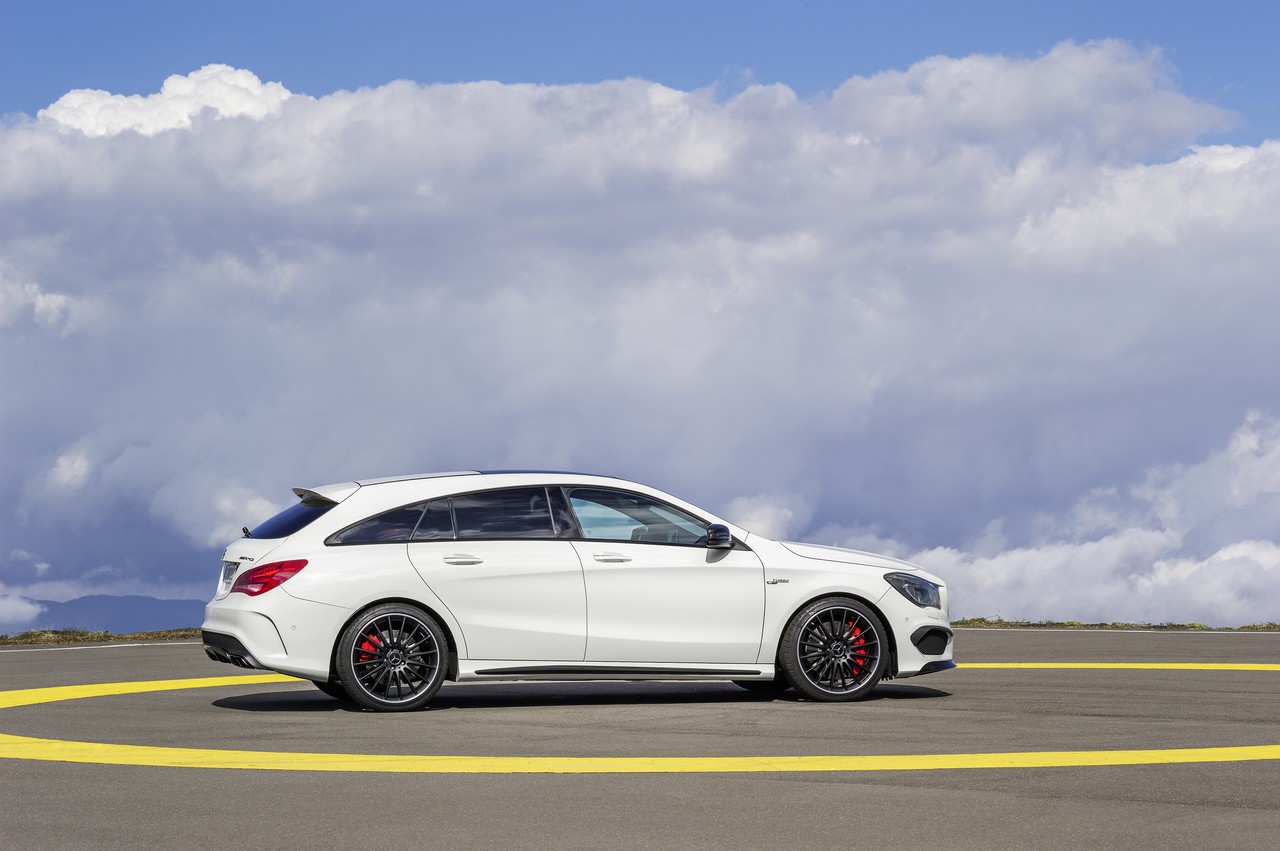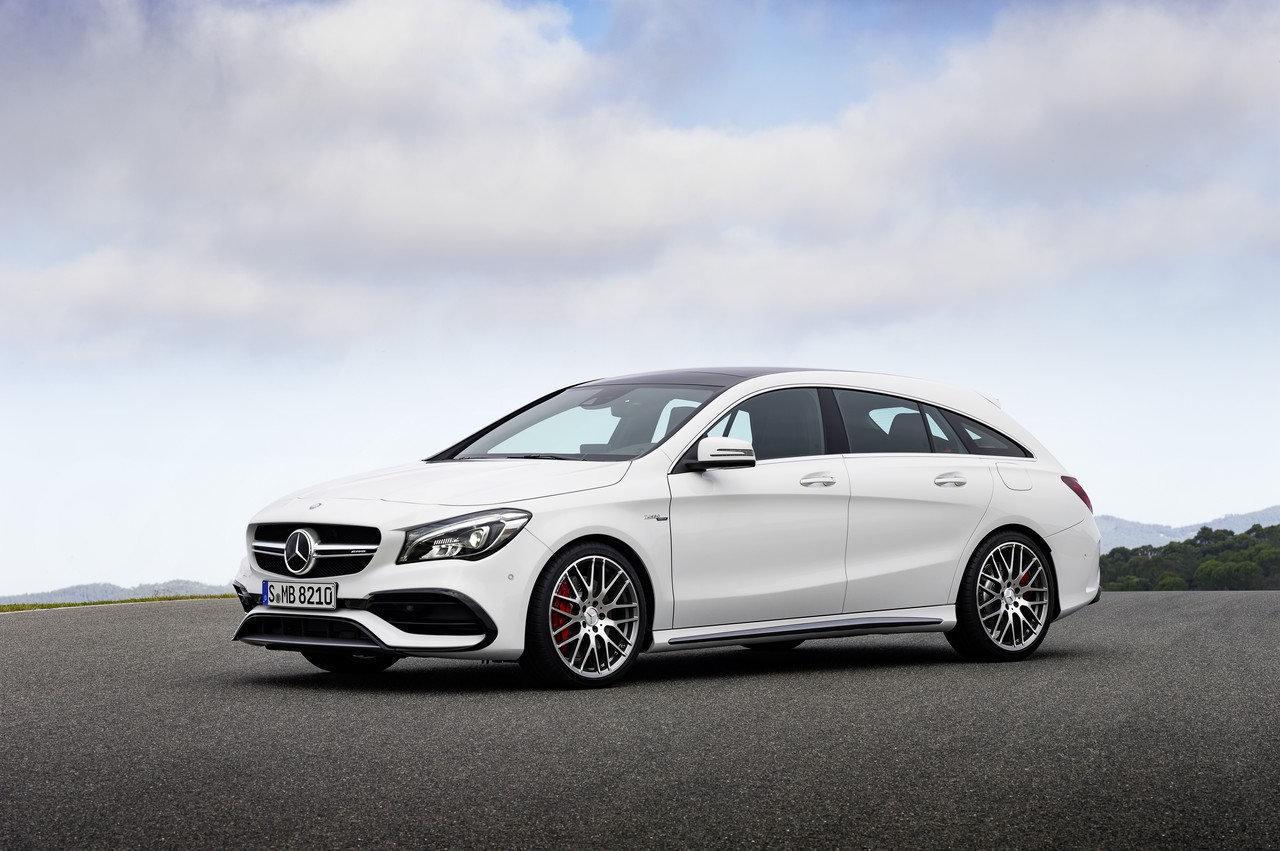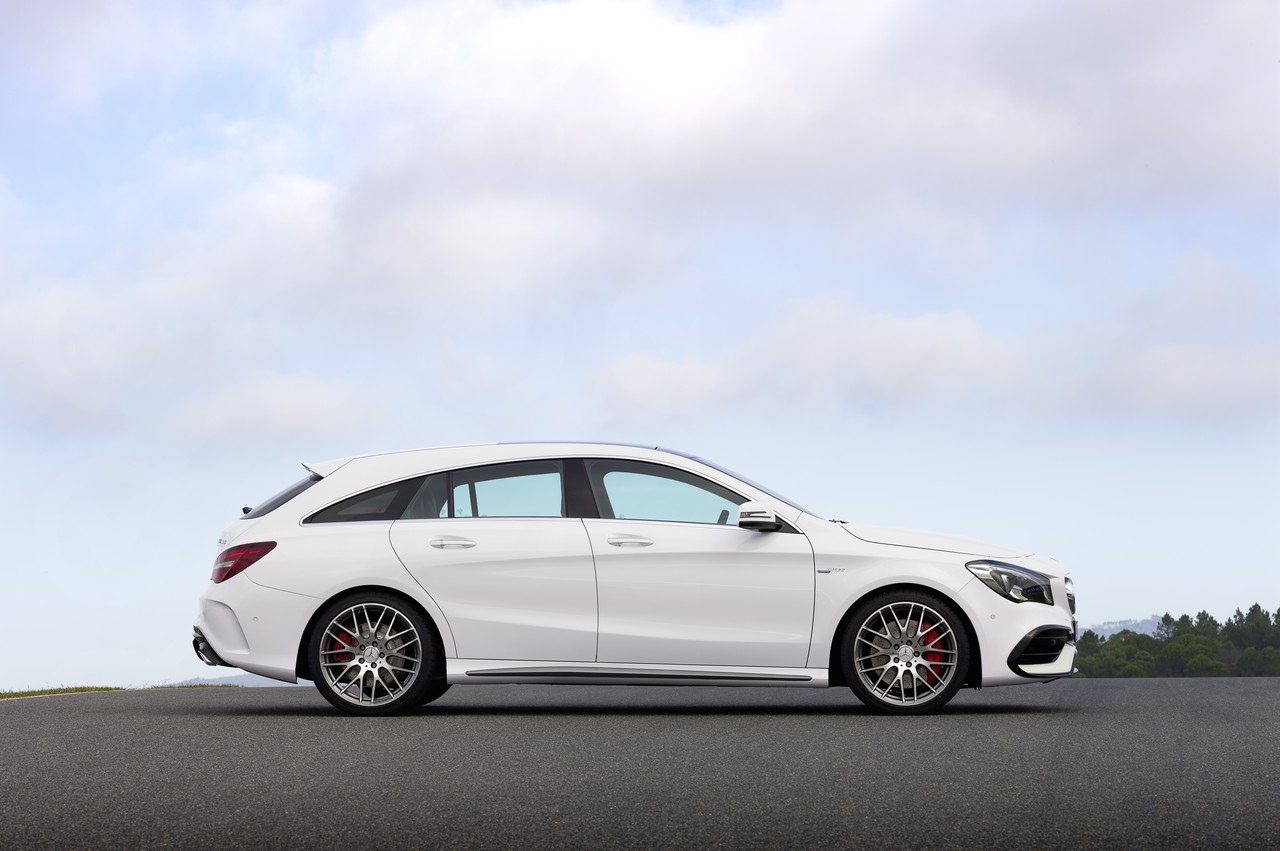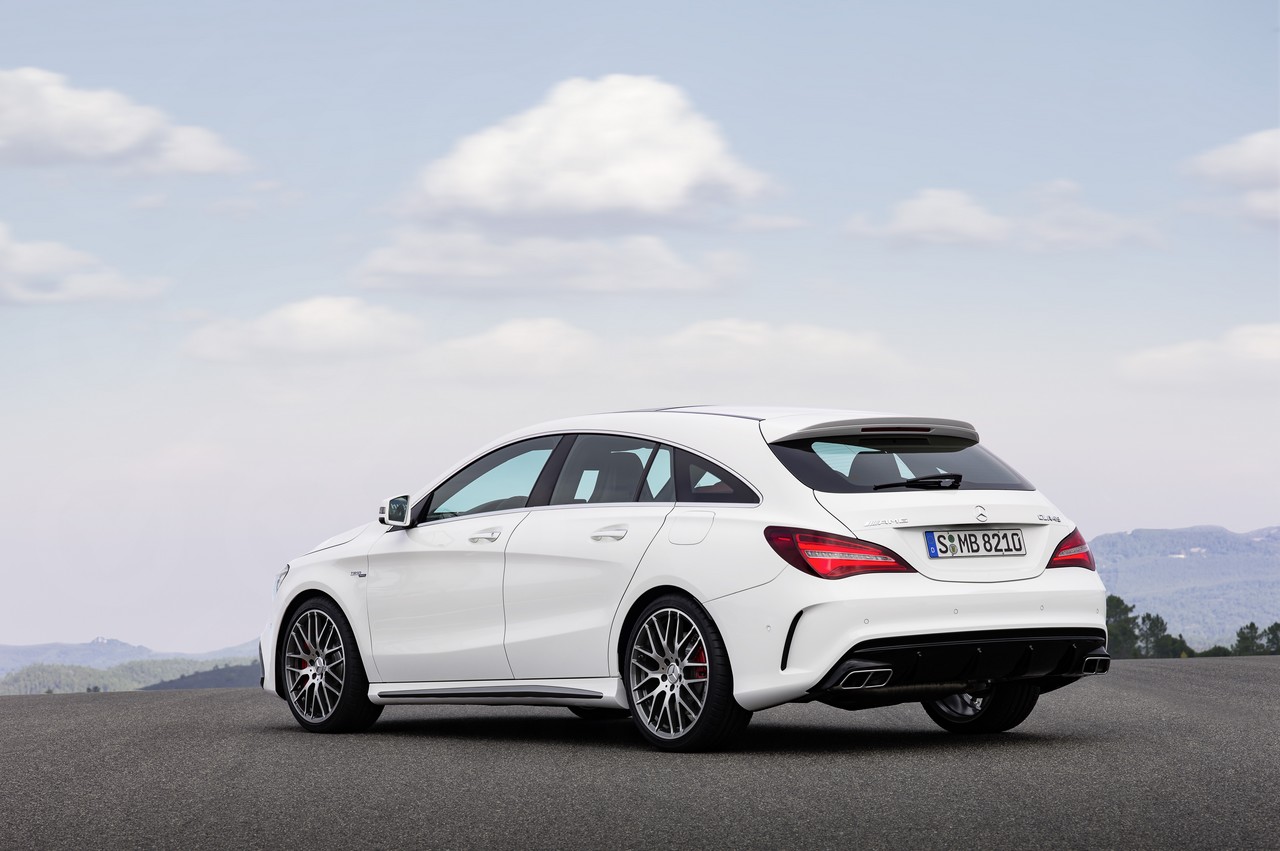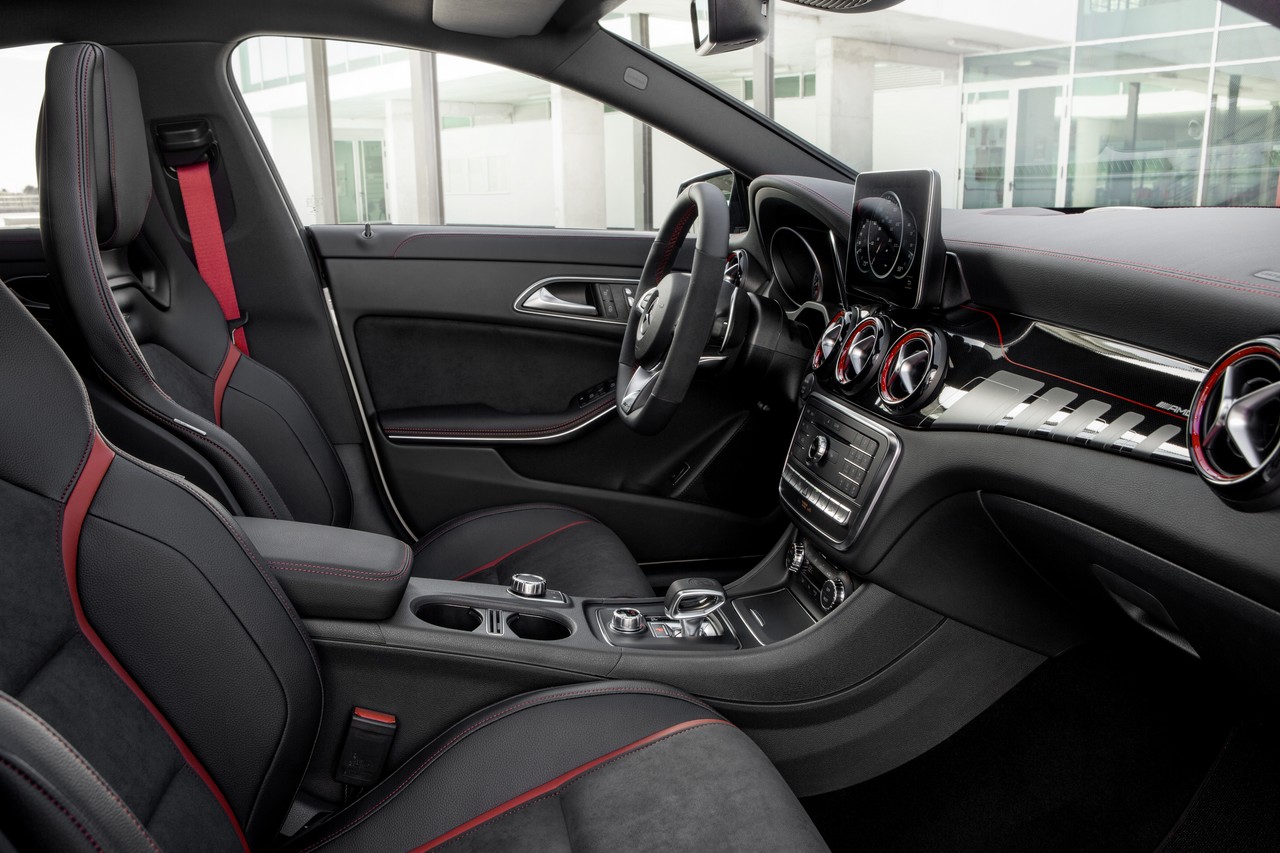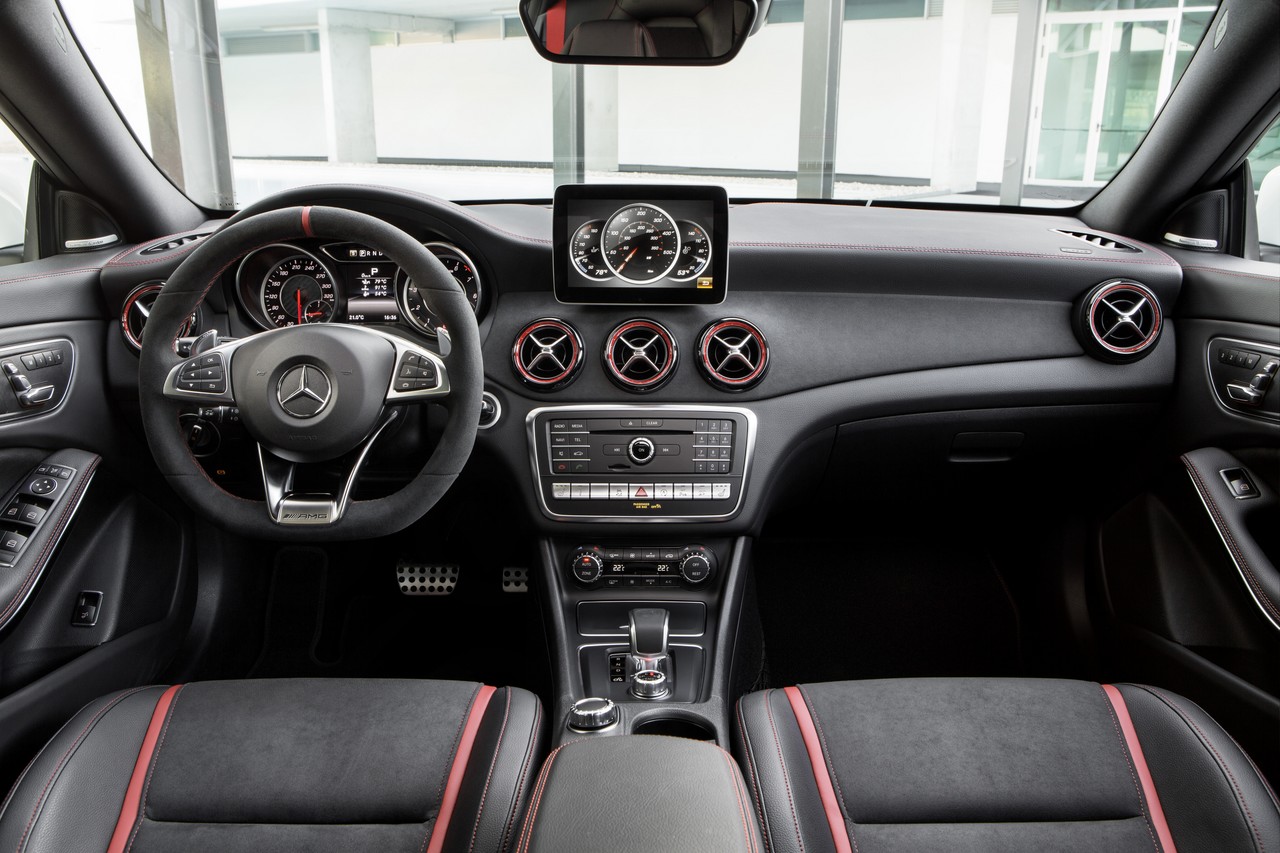
- Powerful 2.0-litre M133 turbo engine has character
- Superb dynamics
- Accurate steering
- Responsive, effective brakes
- Softer dampers than W176 A 45 AMG reduce dynamic ability
Mercedes X117.I CLA 45 AMG Shooting Brake (2015-16)
Overview
Released in Australia in June 2015, the Mercedes-Benz X117 CLA 45 AMG Shooting Brake was a compact wagon. Manufactured in Kecskemet, Hungary, the all-wheel drive X117 CLA 45 AMG Shooting Brake was powered by a 2.0-litre turbocharged petrol engine that was mated to a seven-speed double clutch transmission.
M133 engine
Shared with the W176 A 45 AMG , the four-cylinder M113 engine was hand-produced by MDC Power GmbH in Kölleda, Germany. The M133 engine had a gravity-die sandcast all-aluminium crankcase with ventilation bores, an aluminium cylinder head, a forged steel crankshaft, forged pistons with friction-optimised piston rings, NANOSLIDE coating for the cylinder walls, ‘spectacle honed’ cylinder liners (i.e. surface treatment applied when already bolted in place), spray-guided direct injection via piezo injectors (operating between 100 bar and 200 bar), a twin-scroll turbocharger which provided maximum boost pressure of 1.8 bar (26.1 psi), air-to-water intercooling, double overhead camshafts, continuously variable camshaft adjustment, four valves per cylinder and a compression ratio of 8.6:1. Furthermore, maximum engine speed was 6700 rpm.
Compliant with EU6 emissions standards, the M133 engine could perform up to five injections per combustion cycle in the cold-start and warm-up phases to reduce emissions. Furthermore, the M133 engine had an ECO start/stop function which enabled it to shut down when the vehicle was stationary in traffic to minimise fuel consumption.
Upon its release, the CLA 45 AMG Shooting Brake could accelerate from rest to 100 km/h in 4.7 seconds and had an electronically-limited top speed of 250 km/h. Over the combined ADR 81/02 test cycle, fuel consumption for the CLA 45 AMG Shooting Brake was 7.2 litres per 100 km.
From September 2015 production, the M113 engine produced 280 kW and 475 Nm. According to Mercedes, the increase in power for the M133 engine was due to a ‘newly configured valve assembly’, reconfigured timing and turbocharging; maximum charge pressure, however, remained at 1.8 bar. To reduce fuel consumption, a newly introduced ‘sailing’ function could decouple the engine from the powertrain when the driver released the accelerator at speeds from 60 km/h to 160 km/h. As a result of these changes, the post-September 2015 CLA 45 AMG Shooting Brake could accelerate from rest to 100 km/h in 4.3 seconds.
| Engine | Years | Trans. | Peak power | Peak torque |
|---|---|---|---|---|
| 2.0-litre turbo petrol I4 (M133 DE20) | 2015 | 7sp DCT | 265 kW at 6000 rpm | 450 Nm at 2250-5000 rpm |
| 2015-16 | 7sp DCT | 280 kW at 6000 rpm | 475 Nm at 2250-5000 rpm |
AMG Speedshift DCT transmission
The AMG Speedshift DCT (double clutch transmission) was directly flange-mounted on the transversely installed engine and offered three driving programmes:
- Controlled Efficiency (‘C’): enabled the ECO start/stop function and provided softer throttle response, smooth gearshifts and earlier upshifts for fuel efficient driving;
- Sport (‘S’): disabled ECO start/stop, provided greater throttle response, higher engine speeds before upshifting and faster gearshifts. Under full loads, ignition and injection could be briefly interrupted during upshifts for faster gearshifts and a ‘particularly throaty sound’; and,
- Manual (‘M’): for manual gearshifts via the steering wheel paddles.
In all modes, the DCT had a double declutching function during downshifting, though its characteristics varied according to the selected mode. Furthermore, in C and S modes, a ‘Momentary M’ mode enabled the driver to activate manual mode (‘M’) – without having to remove a hand from the steering wheel – by pressing the ‘up’ of ‘down’ shift paddle once. The transmission would subsequently revert to the previously selected mode based on the current driving situation and driving style.
From September 2015 production, shorter ratios were introduced for the third through seventh forward gears and new ‘Dynamic Select’ transmission modes were introduced:
- Comfort: for ‘comfort-oriented driving’ with a ‘subdued’ engine note and gentle gearshifts. In Comfort mode, the newly introduced ‘sailing’ function could decouple the engine from the powertrain when the driver released the accelerator at vehicle speeds between 60 km/h and 160 km/h. The ECO start/stop function was also active in Comfort mode;
- Sport: provided greater throttle response, more aggressive gearshifts and a more ‘throaty’ engine sound. Furthermore, the sailing and ECO start/stop functions were disabled;
- Sport+: provided faster gearshifts and a modified shift strategy which included double de-clutching. Furthermore, Sport+ enabled partial cylinder suppression – via a momentary and defined retardation of ignition and injection under full throttle – for rapid gearshifts;
- Individual: enabled the driver to vary individual parameters for the engine, transmission and three-stage electronic stability control; and,
- Race: provided ‘even more immediate’ response for the engine and throttle than Sport+, and was configured to maintain an optimum engine speed in the lowest possible gear when driving at racetrack speeds.
4MATIC all-wheel drive system
The Mercdes CLA 45 AMG Shooting Brake’s Haldex all-wheel drive system utilised an electrohydraulically controlled multi-disc clutch which was integrated with the rear axle differential. In normal driving, torque was directly entirely to the front wheels for optimum efficiency. If slip was detected at the front wheels, however, a hydraulic pump would instantaneously press the clutch discs together to direct up to 50 per cent of the engine’s torque to the rear axle (i.e. a 50:50 front:rear torque split). The all-wheel drive system provided a variable torque distribution, with the front:rear determined by vehicle speed, lateral and longitudinal acceleration, steering angle, speed difference between the individual wheels, selected gear and accelerator position.
Dimensions
Compared to the C117 CLA 45 AMG sedan on which it was based, the X117 CLA 45 AMG Shooting Brake was the same length (at 4691 mm), width (1777 mm) and had the same length wheelbase (2699 mm), though was 1 mm taller (1417 mm). The X117 CLA 45 AMG Shooting Brake was, however, 30 kg heavier, with a kerb weight of 1615 kg.
Cargo volume for the CLA 45 AMG Shooting Brake was 495 litres, though this increased to 1354 litres when the rear seats were folded down.
Suspension
The Mercedes CLA 45 AMG Shooting Brake had three-link front suspension with MacPherson struts and four-link rear suspension which consisted of three control arms and one trailing arm per wheel; both front and rear suspension included coil springs, gas-pressure shock absorbers and anti-roll bars. Compared to the X117 CLA Shooting Brake , changes for the CLA 45 AMG Shooting Brake included:
- Stiffer springs and dampers;
- Additional negative camber front and rear;
- Thicker stabiliser bars;
- For the front suspension, more rigid bearings in the lower link plane;
- Stiffer steering knuckles;
- Modified rear strut bearings; and,
- More rigid rear axle bearings.
From September 2015 production, the CLA 45 AMG Shooting Brake was equipped with ‘AMG Ride Control’ which consisted electronically-controlled dampers that could be varied at each wheel according to the driving situation and road conditions. The driver could also pre-select the basic damping characteristics in two stages.
Steering
The Mercedes X117 CLA 45 AMG Shooting Brake had an electromechanical power steering (EPS) system with a steering ratio of 14.5:1. Furthermore, the EPS system also had the following functions:
- Counter-steering in the event of over-steer;
- Corrective steering when braking on road surfaces with different levels of grip (split-friction braking);
- Mitigating the extent to which front-wheel drive influences the steering;
- Compensating cross winds and road gradients; and,
- Active Parking Assist, which used sensors on the front bumper to measure parking spaces and provided automated steering for the parking manoeuvre.
Safety equipment
Standard safety equipment for the Mercedes X117 CLA 45 AMG Shooting Brake included dual front airbags, a driver’s knee airbag, front and rear side airbags, full-length curtain airbags, ABS, electronic brake force distribution, brake assist, electronic stability control, traction control, front seatbelts with pre-tensioners and force limiters, an ‘active bonnet’, and Mercedes-Benz’s automatic emergency call system.
Further safety technologies – fitted as standard – for the CLA 45 AMG Shooting Brake included:
- Mercedes-Benz’s ‘Pre-Safe’ system: activated by emergency braking, panic braking, pronounced over- or under-steering, critical steering movements or heavy support by the adaptive Brake Assist system. In response, Pre-Safe would prepare for a collision by deploying the seatbelt tensioners, close the side windows and sliding sunroof (where fitted) and adjust of the front passenger seat to an ideal position for maximum effectiveness of the restrain systems;
- Collision Prevention Assist (radar-based collision warning with adaptive Brake Assist): Collision Prevention Assist operated at speeds between 7 km/h and 250 km/h, and could detect stationary objects when driving at speeds of up to 70 km/h. Collision Prevention Assist monitored the distance to the vehicle ahead, would provide visual and audible warning to the driver if there was a collision risk and would optimise braking power (adaptive Brake Assist) for when the driver depressed the brake pedal. At initial speeds of less than 20 km/h, Collision Prevention Assist could prevent rear-end collisions;
- Distronic Plus (adaptive cruise control with brake warning): an ‘adaptive’ cruise control system which used two short-range radar sensors positioned behind the front bumper to monitor the road up to 30 metres ahead, and a long-range radar located behind the radiator grille which had a range of 200 metres. Operating at speeds up to 200 km/h, Distronic Plus used an electronic control unit to analyse the information from both radar systems to calculate the engine, automatic transmission and braking parameters required for proximity control. As such, Distronic Plus could automatically apply the brakes to prevent the vehicle from becoming too close to traffic ahead (the time interval could be specified) and accelerate back to the set speed when traffic allowed. To accelerate from rest, the driver only needed to operate the Distronic stalk on the steering column or briefly depress the accelerator pedal. With Distronic Plus, automatic deceleration of up to four (4) m/s2was possible. If Distronic Plus detected that heavier braking was required, a warning light would illuminate in the instrument cluster and be accompanied by an audible warning. Furthermore, the electronic proximity control system could be activated independently of Distronic Plus at speeds over 30 km/h to alert the driver if they were approaching another vehicle too rapidly;
- Attention Assist: operated at speeds in excess of 80 km/h and monitored driver behaviour and steering movements for signs of drowsiness; if detected, the driver would be provided with visual and audible warnings;
- Blind spot assist (passive): used two radar sensors in the rear of the vehicle to warn the driver before an indicated lane-change if a vehicle is in the driver’s blind spot; and,
- Lane keeping assist (passive): used a camera behind the windscreen to monitor lane markings and detect if the vehicle was drifting outside its lane. If so, acoustic and visual warnings would be issued.
Stability control system
The electronic stability control system (Mercedes-Benz’s Electronic Stability Program, or ESP) had an ‘ESP Sport Handling’ mode which raised thresholds for intervention; the electronic stability control could also be switched off if desired. When ‘ESP Sport Handling’ mode was engaged, the driver could select the ‘Race Start’ function for optimum acceleration from rest.
The stability control system also included an ‘ESP Curve Dynamic Assist’ function that provided slight braking applications to the inside wheel when cornering to produce a yaw moment around the vertical axis to increase turn-in.
Brakes
The CLA 45 AMG Shooting Brake had 350 mm by 32 mm front brake discs with four-piston callipers and 330 mm by 22 mm rear discs with single-piston callipers; both front and rear discs were ventilated and perforated.
Features: CLA 45 AMG Shooting Brake
Standard features for the CLA 45 AMG Shooting Brake included 19-inch AMG multi-spoke alloy wheels with 235/35 R19 tyres, a Harman Kardon Logic7 surround sound system with twelve speakers, a single-disc CD/DVD player, digital radio tuner (DAB+), MP3/WMA/AAC compatibility, auxiliary inputs (3.5 mm/USB/iPod), Bluetooth mobile phone connectivity and audio streaming, COMAND APS with a 17.8 cm display, HDD navigation, 10 GB music register, internet access and voice recognition (‘Linguatronic’), dual-zone climate control air conditioning (‘Thermotronic’), AMG seats in black ‘Red Cut’ leather, power adjustable and heated front seats, cruise control, bi-xenon headlights with integrated daytime LED running lights, front and rear parking sensors, a reversing camera with dynamic guidelines, automatic headlights, rain-sensing wipers, an AMG steering wheel with nappa leather and Alcantara trim, 40:60 split and folding rear seats, remote central locking, power adjustable mirrors with heating and folding functions, kerb view tilting of the passenger door mirror on reversing, power windows, a power-operated panoramic sunroof, automatically dimming rear-view and door mirrors, front seat memory settings, ambient lighting, tinted windows, rear privacy glass, AMG instrument cluster with ‘Racetimer’, a trip computer, an alarm and immobiliser.
AMG Performance exhaust
For Australia, the CLA 45 AMG Shooting Brake was fitted with an AMG Performance exhaust system which included a switchable exhaust flap that varied the exhaust note. Compared to the standard twin-pipe exhaust system, the AMG Performance exhaust provided a ‘more emotive, fuller engine sound when driving under full load and when changing gears’.
Specifications
Related links
Mercedes-AMG X117.II CLA 45 Shooting Brake (2016-19)
Overview
Commencing production in June 2016, the Mercedes-AMG X117 Series II (X117.II) CLA 45 Shooting Brake could be identified by the new A-wing design of its front apron which included splitter inserts in matt titanium grey and high-gloss black flics; a new rear diffuser insert with four vertical fins was also introduced.
| Engine | Years | Trans. | Peak power | Peak torque |
|---|---|---|---|---|
| 2.0-litre turbo petrol I4 (M133 DE20) | 2016-19 | 7sp DCT | 280 kW at 6000 rpm | 475 Nm at 2250-5000 rpm |
Safety equipment
Compared to the X117.I CLA 45 Shooting Brake, standard safety equipment for the X117.II CLA 45 Shooting Brake was extended to include ‘Active Brake Assist’. Operating at speeds up to 250 km/h to monitor the traffic ahead and at speeds up to 50 km/h for stationary objects, Active Brake Assist would issue a visual warning (when driving at speeds over 7 km/h) and an optical warning (when driving at speeds over 30 km/h if there was a collision risk. At speeds below 105 km/h (250 km/h in conjunction with Distronic Plus), Active Brake Assist would initially provide partial autonomous braking to reduce vehicle speed and alert the driver. Furthermore, adaptive Brake Assist would calculate the braking force required and prime the braking system for optimum response when the driver depressed the brake pedal. If the driver did not respond and a collision was unavoidable, then maximum braking force would be applied to reduce vehicle speed. At initial vehicle speeds of up to 40 km/h, rear-end collisions could be prevented.
Features
For the X117.II CLA 45, standard features were extended to include Mercedes’ ‘COMAND Online’ infotai Nment system with a 20.3 centimetre TFT display (previously COMAND APS with a 17.8 cm display), Apple CarPlay and Android Auto smartphone integration, a Garmin MAP Pilot navigation system (previously Becker), and LED headlights with integrated LED daytime running lights.
Specifications
Related links
- Daimler Media: the new Mercedes-Benz CLA and CLA Shooting Brake (March 2016)
- Mercedes-AMG: CLA 45 Shooting Brake
- Wikipedia.org: Mercedes-Benz CLA-Class
